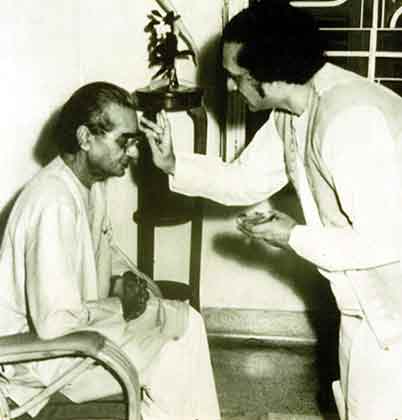
|
|
|
|||
|
|
||||
|
|
Uday Shankar’s Short Biography [1900-1977]
Pic: A 1931 photo of Uday in performance Uday Shankar was the eldest son of Barrister Syam Shankar of Jessore, which is now in Bangladesh. He comes from a very cultured family where children were taught to paint, sing, dance, etc. Uday had three brothers, Rajendra, Davendra, and Rabindra, the youngest brother, Rabindra, is better known as Pundit Ravi Shankar - the sitar virtuoso, who is still alive. He was a gifted painter who studied at the J. J. School of the Arts in Bombay. Then he went to England in the early 1920s to study painting at the Royal College of Art in London. While he was studying in London, he choreographed two ballads of which one was based on Hindu mythology ("Krishna and Radha") and the other on Hindu society ("A Hindu Wedding"). These two ballads were premiered at the Covent Garden. That was the time when he came in contact with the famous Russian ballerina, Anna Pavlova. He worked with her and learned ballet movements, which he incorporated in his future work. <!--[endif]--> Uday Shankar returned to India in 1929 and soon formed his own dance troupe. Between 1932 and the 1960s, the troupe crisscrossed Europe. He brought his troupe to America in 1937. In 1938, he opened a dance school in Almora, U.P. calling it "Uday Shankar Indian Culture Center." The center was closed during World War II but it reopened in Kolkata after the war in 1965. The school was however renamed "Uday Shankar Center for Dance." He married his student, Amala, circa in late thirties. Their son, Ananda—an accomplished rock-fusion Jazz musician, was born in 1942. They also have a daughter, Mamata. After Uday's death in 1977, his widow Amala Shankar took the charge of the school. She is still alive as of this writing (December 17, 2004). Her school in Kolkata continues to teach an all-embracing performance curriculum that includes training in folk and classical dance, improvisation, costume design and theatrical makeup.
Pic: Uday and his new bride Amala Uday Shankar was a born dancer. He never took any formal training in classical dances in India before he went to England in 1929. While in Europe he was exposed to ballet. The graceful movement of ballet dancers must have impressed him. He incorporated ballet movements in Indian dance for the first time; thus, he engendering a "new kind" of Indian dance. His dances were rooted in Hindu mythology; he used amply classical raga music in his choreography. The Europeans loved his "new style" of dancing. Knowing how rigid our Indian dances were in the 1920s and 1930s, it took a while before Indians started appreciating Uday’s "new style," which was hybrid in nature. The old folks were not enthused by Uday’s “new style” of dance but the young generation was awed by his style and many of them had joined his school in Almora, U.P. <!--[endif]-->His school was a waterhole for many aspiring and talented dancers. Many graduates of the school have gone into other areas of fine arts. The famous Bombay film director, Guru Dutt had attended Uday’s school. The famous classical singer, Srimati Laxmi Shankar, had attended Uday’s school at Almora. She was advised by Ravi Shankar to change her career from dancing to singing. She later married Rajendra Shankar, the younger brother of Uday Shankar. The dancer par excellence can be labeled as the renaissance dancer who modernized the stylized temple dance of India and popularized the art form allover the West. Bangladesh’s one-time famous dancer, Bulbul Chowdhury, was a student in Uday’s school of dancing in the 1940s. Bulbul died at a young age in 1950s. His dance school, Bulbul Academy of Fine Arts (BAFA), is the premier school of dance in Bangladesh.
Uday’s birth centenary was held in India in the year 2000. Many articles were written then in newspapers throughout India. Mukto-mona salutes this Renaissance man. To honor Uday Shankar we have assembled quite a few articles and a plethora of marvelous photos from the Internet. Together, these articles and photos will portray the geniuses of this great choreographer and dancer. Enjoy the articles and photos. ---------------------------- This article was written by A.H. Jaffor Ullah specially for Mukto-mona. No part of this article can be reprinted in any format without written permission of Mukt-mona.
|
|
||
|
|
|
|||


